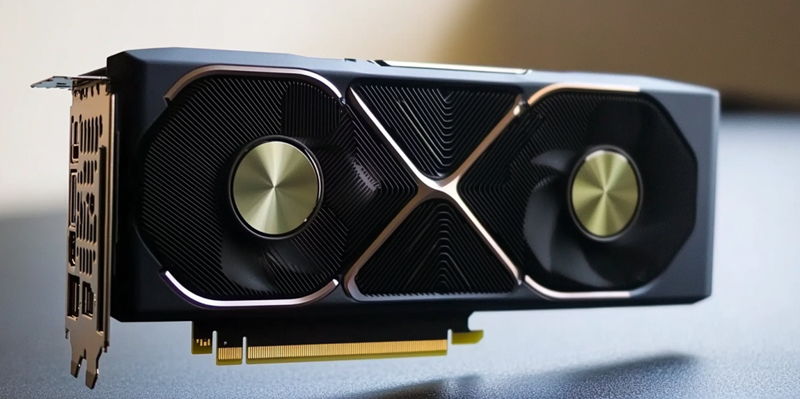The tech world is abuzz with rumors and leaks regarding Nvidia’s highly anticipated GeForce RTX 5000 series of graphics processing units (GPUs). As speculation mounts about the impending launch, industry insiders and enthusiasts are eagerly awaiting the next generation of Nvidia’s flagship GPUs. These revelations have sparked considerable excitement, suggesting significant advancements in performance and capabilities, potentially setting new benchmarks for the industry.
Anticipated Features and Specifications
Enhanced VRAM and Performance
One of the standout features rumored for the Nvidia GeForce RTX 5000 series is the significant increase in VRAM, with the flagship RTX 5090 expected to sport a whopping 32GB of VRAM. This represents a notable upgrade from the RTX 4090’s 24GB, promising enhanced performance for both gaming and professional applications. The increased VRAM capacity is anticipated to support more complex and resource-intensive tasks, such as 4K and 8K gaming, advanced AI workloads, and intricate 3D rendering.
The new GPUs are also rumored to be built on Nvidia’s latest Blackwell architecture, which is expected to bring several improvements over the previous generation. Blackwell is likely to incorporate advanced AI capabilities and enhanced features such as Deep Learning Super Sampling (DLSS) and Frame Generation, which improve visual quality and performance. These advancements suggest that the RTX 5000 series will offer a significant leap in terms of computational power and efficiency, catering to the growing demands of modern software and gaming experiences.
Pricing Concerns and Scalping Issues
While the technological advancements of the RTX 5000 series are undeniably impressive, concerns have been raised about the potential pricing of these GPUs. Early rumors suggest that the RTX 5090 could be priced as high as $2,500, a substantial increase from the RTX 4090’s initial price of $1,599. This dramatic price hike has led to apprehension among consumers and industry observers, as it may make the new GPUs less accessible to a broader audience and spark issues related to affordability.
Moreover, the high price point opens the door to potential scalping problems, reminiscent of the challenges faced during the COVID-19 pandemic. During that time, supply chain disruptions and increased demand led to widespread scalping and exorbitant prices for highly sought-after hardware. If Nvidia’s new GPUs follow a similar pattern, consumers may find it difficult to obtain these products at reasonable prices, leading to frustration and market instability.
Broader Implications for Gamers and Tech Enthusiasts
AI-Driven Advancements and VRAM Capacity
The integration of advanced AI capabilities in Nvidia’s RTX 5000 series signifies a pivotal turn in GPU technology. These AI-driven enhancements are poised to offer substantial improvements in performance and efficiency, vastly benefiting gamers, developers, and tech enthusiasts. AI-powered features like DLSS contribute to sharper, higher-quality graphics while maintaining smooth frame rates, making for a richer and more immersive gaming experience. Additionally, Frame Generation technology may reduce latency and enhance overall responsiveness, crucial for competitive gaming scenarios.
The expanded VRAM capacity inherent in the RTX 5090 is particularly noteworthy for professional applications in fields such as design, animation, and scientific computation. Increased VRAM allows for handling more extensive datasets and more complex simulations, thus accelerating workflow efficiency and productivity. This boost is likely to appeal not only to gamers looking for superior performance but also to professionals seeking powerful tools for demanding tasks.
Market Accessibility and Demand Complexities
Despite the excitement over the advanced features of Nvidia’s upcoming GPUs, the anticipated steep price may hinder widespread market adoption. With an expected price tag of up to $2,500 for the RTX 5090, the new GPUs could be out of reach for many potential consumers. This raises concerns about market accessibility and the broader implications for both Nvidia’s sales and the overall technology market. High prices combined with anticipated high demand could exacerbate the availability issues seen with previous GPU releases, leading to frustration among consumers and influencing purchasing decisions.
Furthermore, the potential for scalping, driven by limited initial supplies and high demand, could result in inflated secondary market prices. This scenario was notably problematic during the pandemic when hardware shortages led to significant market disruptions. If such patterns recur with the RTX 5000 series, it may add layers of complexity for both consumers trying to purchase these GPUs and Nvidia in managing supply chains and market expectations.
Conclusion
The tech community is buzzing with rumors and leaks surrounding Nvidia’s much-anticipated GeForce RTX 5000 series of graphics processing units (GPUs). As whispers about the forthcoming release grow louder, both industry insiders and tech enthusiasts are on edge, eagerly awaiting the next wave of Nvidia’s leading GPUs. These emerging details have created an atmosphere of excitement, hinting at substantial advancements in performance and capabilities. The anticipation suggests that Nvidia might be positioned to set new benchmarks within the industry, raising the bar for what gamers, developers, and graphic professionals can expect in terms of speed, efficiency, and overall technology.
With each passing day, the speculation around the RTX 5000 series intensifies, fueled by purported leaks that tease groundbreaking enhancements over its predecessors. Enthusiasts hope for improved ray tracing, greater power efficiency, and increased compute power, which could revolutionize gaming and professional graphics work. If these claims hold true, the RTX 5000 series could solidify Nvidia’s position as a dominant force in the GPU market, driving innovation and pushing the boundaries of what’s technologically possible.

